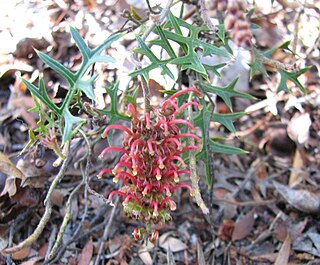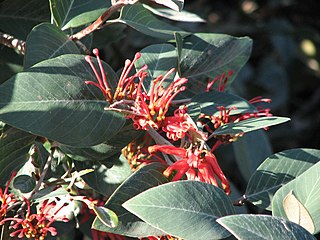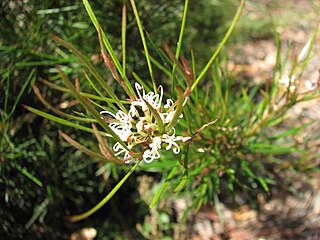
Threatened species are any species which are vulnerable to endangerment in the near future. Species that are threatened are sometimes characterised by the population dynamics measure of critical depensation, a mathematical measure of biomass related to population growth rate. This quantitative metric is one method of evaluating the degree of endangerment.

Grevillea floripendula, also known as Ben Major grevillea, is a prostrate or spreading shrub which is endemic to a small area in central western Victoria in Australia. It grows up to 1 metre in height and 3 metres in width. The inflorescence is suspended on a long, thin peduncle. The individual flowers are green-grey to purplish-brown and appear between October and December in the species' native range.

Grevillea microstegia, the Mount Cassell grevillea, is a spreading shrub which is endemic to the Grampians National Park in Victoria, Australia. It grows to between 0.3 and 1 metre in height and 2 to 4 metres in width. The flowers are reddish-brown and have green-tipped red styles. These appear between November and December in its native range.

Grevillea infecunda, commonly known as Anglesea grevillea, is a root-suckering shrub which is endemic to Victoria, Australia. It grows to 0.3 to 1.2 metres in height. The flowers are yellowish-green, ageing to orange-red. These appear between October and December in its native range.

Grevillea celata, the Nowa Nowa grevillea or Colquhoun grevillea, is a shrub which is endemic to Victoria, Australia. It is closely related to Grevillea alpina and Grevillea chrysophaea.

Grevillea montis-cole is a shrub which is endemic to central-western Victoria, Australia. It has similarities in appearance to Grevillea microstegia, Grevillea floripendula and Grevillea aquifolium but has larger floral bracts. The flowers, which appear between October and March in its native range, have greenish to fawn perianths and red styles.

Grevillea gariwerdensis is a species of the plant genus Grevillea. It is endemic to Victoria in Australia. The species grows as a low, suckering shrub, between 0.3 and 1 metre in height. Flowers usually appear between October and January in its native range. These have perianths and styles which are white to pink. It is very similar in appearance to both Grevillea micrantha and Grevillea parviflora. The name Grevillea linearifolia has been misapplied to this species in the past.

Grevillea dimorpha, the flame grevillea, is a species in the plant genus Grevillea. It is endemic to Victoria in Australia. The species grows to between 0.4 and 3 metres in height. Flowers usually appear between August and December in its native range. These have red perianths and styles.

Grevillea burrowa, commonly known as Burrowa grevillea, is a species of Grevillea from Burrowa-Pine Mountain National Park in the north-east of Victoria in Australia. It is a shrub with ovate leaves and red flowers.

Grevillea parvula , commonly known as Genoa grevillea, is a species of the plant genus Grevillea. It is native to the states of Victoria and New South Wales in Australia.

Grevillea polychroma , commonly known as Tullach Ard grevillea, is a species of the plant genus Grevillea. It is endemic to the state of Victoria in Australia. The taxon was first formally described as a subspecies of Grevillea brevifolia in 2000. It was promoted to species status in 2005. The species is listed as "Rare in Victoria" on the Department of Sustainability and Environment's Advisory List of Rare Or Threatened Plants In Victoria.
Grevillea micrantha, also known as small-flower grevillea, is a shrub that is endemic to the state of Victoria in Australia. It grows to between 0.3 and 0.6 metres in height and has narrow leaves that are 1 to 4 cm in length and 0.6 to 1 mm in width. The white or pale pink flowers appear between August and January in the species' native range.
Grevillea brevifolia, commonly known as Cobberas grevillea, is a species of the plant genus Grevillea. It is native to the states of Victoria and New South Wales in Australia. The red flowers appear between November and December in the species' native range. The species was first formally described by Victorian Government Botanist Ferdinand von Mueller in 1879 in Flora Australiensis, based on a collection from Mount Tambo in Victoria. The former subspecies G. brevifolia subsp. polychroma was elevated to species status as Grevillea polychroma in 2005. Grevillea brevifolia is listed as "Rare in Victoria" in the Department of Environment and Primary Industries' Advisory List of Rare Or Threatened Plants In Victoria. The species occurs in sub-alpine areas including the Pilot Wilderness, the Cobberas-Tingaringy Unit of the Alpine National Park, and Mount Seldom Seen.
Grevillea monslacana, commonly known as Lake Mountain grevillea, is a shrub species which is endemic to mountainous areas of eastern Victoria in Australia. It grows to 2 metres in height. The species, which was first formally described in 2000, is listed as "Rare in Victoria" on the Victorian Department of Sustainability and Environment's Advisory List of Rare Or Threatened Plants In Victoria. It was previously known as the Lake Mountain form of Grevillea victoriae.

Grevillea neurophylla, commonly known as granite grevillea, is a shrub species in the family Proteaceae. It is native to the states of New South Wales and Victoria in Australia. The species was first formally described by French botanist Michel Gandoger in Bulletin de la Société Botanique de France in 1919. There are two subspecies:
Grevillea patulifolia, commonly known as swamp grevillea, is a shrub species in the family Proteaceae. It is native to the states of New South Wales and Victoria in Australia.
Grevillea polybractea, commonly known as crimson grevillea, is a shrub species in the family Proteaceae. It is native to the states of New South Wales and Victoria in Australia.
Grevillea molyneuxii, commonly known as the Wingello grevillea, is a shrub which is endemic to the shrublands of New South Wales in Australia.

Buddleja limitanea is a small deciduous shrub. Discovered by George Forrest in Yunnan (1912) and in northern Burma (1914), described by William Wright Smith in 1916. Resembling a small B. forrestii and hence sunk under this name by Leeuwenberg, although recognised in horticulture as a separate species.

Argyrochosma limitanea, the southwestern false cloak fern, is a species of fern native to the southwestern United States and Sonora, Mexico. It grows on calcareous rocks, and has small, finely-divided leaves with a leathery texture, dark axes connecting the leaf segments, and a heavy coating of white powder on the undersurface. It reproduces apogamously; two subspecies are recognized, which may have originated independently through the hybridization of other taxa not yet discovered. First described as a species in 1919, it was transferred to the new genus Argyrochosma in 1987, recognizing their distinctness from the "cloak ferns".













